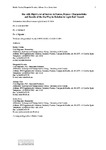Mostrar o rexistro simple do ítem
Bus with high level of service in Nantes, France: Characteristics and results of the bus way in relation to light-rail transit
| dc.contributor.author | Conles Barrera, Emilio José | |
| dc.contributor.author | Novales, Margarita | |
| dc.contributor.author | Orro, Alfonso | |
| dc.contributor.author | Anta, Javier | |
| dc.date.accessioned | 2023-01-09T18:00:24Z | |
| dc.date.available | 2023-01-09T18:00:24Z | |
| dc.date.issued | 2014 | |
| dc.identifier.citation | Conles, E., Novales, M., Orro, A., Anta, J. (2014). Bus with high level of service in Nantes, France: Characteristics and results of the bus way in relation to light-rail transit. [Manuscrito aceptado:] Transportation Research Record, 2418(1), 66–73. https://doi.org/10.3141/2418-08 | es_ES |
| dc.identifier.uri | http://hdl.handle.net/2183/32313 | |
| dc.description | Manuscrito aceptado para publicación (postprint) de: Conles, E., Novales, M., Orro, A., Anta, J. (2014). Buses with High Level of Service in Nantes, France: Characteristics and Results of the BusWay Compared with Light Rail Transit. Transportation Research Record, 2418(1), 66–73. https://doi.org/10.3141/2418-08 | es_ES |
| dc.description.abstract | [Abstract:] This paper is intended to identify and analyze the reasons that have led the BusWay of Nantes (France) to be one of the most – if not the most – outstanding and successful cases of setting up of a BHLS system (Bus with High Level of Service) in European cities, inasmuch the lesson and conclusions extracted from its study may be applicable and useful to other sites experiencing similar conditions. This examination is approached from the point of view of both the measures implemented (infrastructures, vehicles, design of the transit service operations, complementary facilities and services, branding) and the results achieved (level of service in terms of frequencies and operating speed, reliability of the schedules, ridership, traffic safety). Furthermore, as BHLS and LRT (Light Rail Transit) are integrated within the same level of the trunk network in Nantes, this city provides a relatively level playing field to develop a comparison more equitable than usual of both systems. This comparative evaluation is addressed by this paper from the above-mentioned points of view. As general conclusion, this paper shows, through the case study of Nantes, the suitability of the BHLS systems to meet demand volumes in the range from 1,000 to 2,500 passengers/h-direction at peak-hours with a level and quality of service very near the LRT, but with more moderate investment costs and higher flexibility. | es_ES |
| dc.language.iso | eng | es_ES |
| dc.publisher | Sage | es_ES |
| dc.relation.uri | https://doi.org/10.3141/2418-08 | es_ES |
| dc.rights | Atribución-NoComercial-SinDerivadas 3.0 España | es_ES |
| dc.rights.uri | http://creativecommons.org/licenses/by-nc-nd/3.0/es/ | * |
| dc.subject | Nantes bus way | es_ES |
| dc.subject | BHLS systems | es_ES |
| dc.subject | Bus with high level of service | es_ES |
| dc.subject | LRT | es_ES |
| dc.subject | Light rail transit | es_ES |
| dc.title | Bus with high level of service in Nantes, France: Characteristics and results of the bus way in relation to light-rail transit | es_ES |
| dc.title.alternative | Buses with High Level of Service in Nantes, France: Characteristics and Results of the BusWay Compared with Light Rail Transit | es_ES |
| dc.type | info:eu-repo/semantics/article | es_ES |
| dc.rights.access | info:eu-repo/semantics/openAccess | es_ES |
| UDC.journalTitle | Transportation Research Record: Journal of the Transportation Research Board | es_ES |
| UDC.volume | 2418 | es_ES |
| UDC.issue | 1 | es_ES |
| UDC.startPage | 66 | es_ES |
| UDC.endPage | 73 | es_ES |
| dc.identifier.doi | 10.3141/2418-08 |
Ficheiros no ítem
Este ítem aparece na(s) seguinte(s) colección(s)
-
CITEEC-GFT - Artigos [20]






